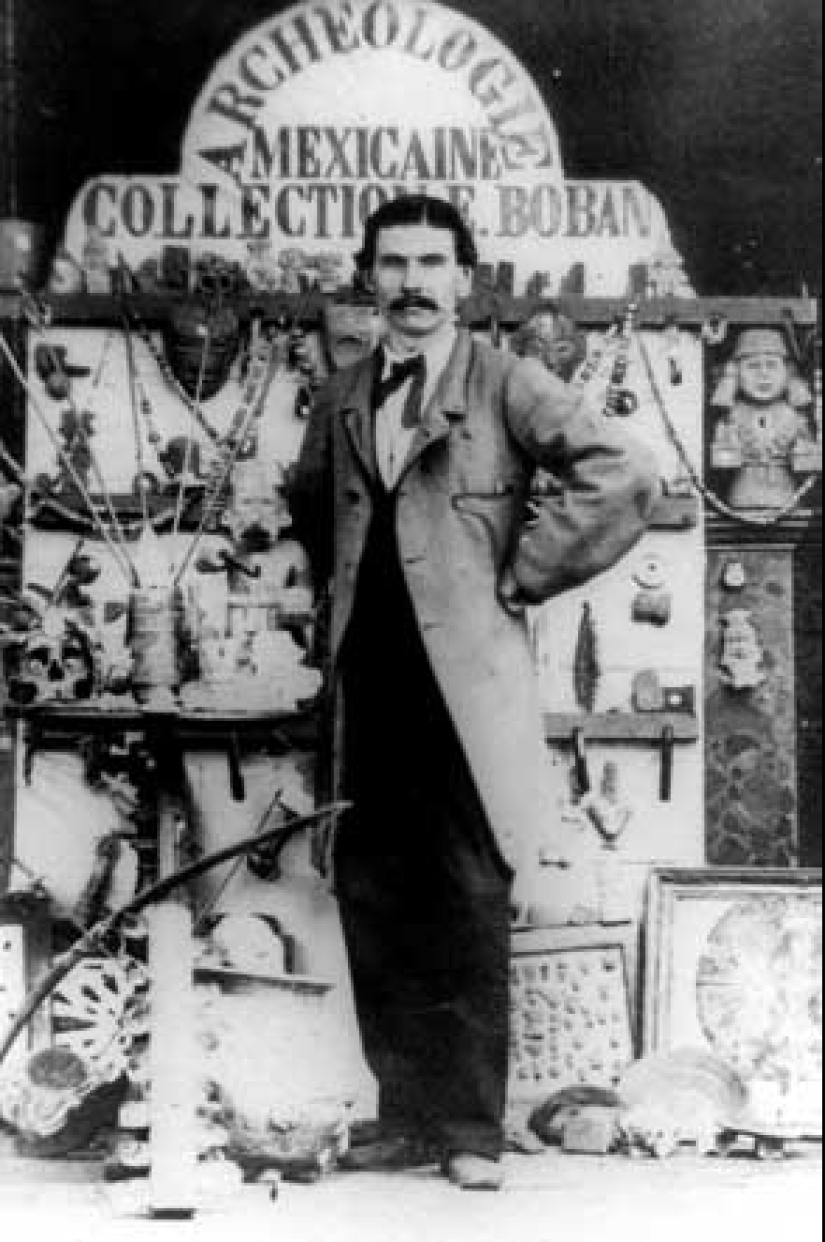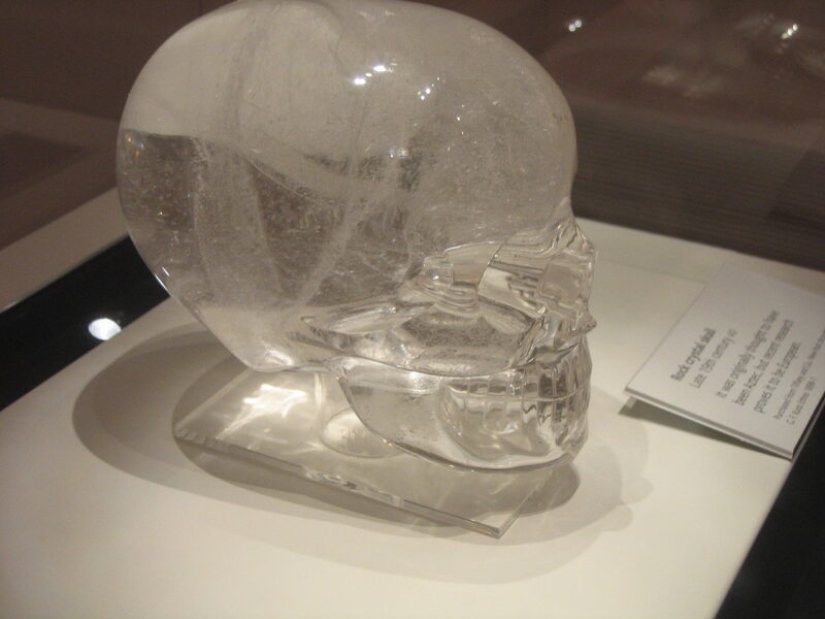Aztec crystal skulls: how exposed one of the largest frauds in archaeology
Categories: History | North America
By Pictolic https://pictolic.com/article/aztec-crystal-skulls-how-exposed-one-of-the-largest-frauds-in-archaeology.htmlAztec crystal skull and scary at the same time beautiful long been the object of desire collectors of ancient artifacts and entire museums. Today, the famous 13 skulls rhinestone, 9 of which are in private collections, and 4 in museums: National Museum of natural history, Smithsonian institution in Washington, the Paris Museum of primitive art in London's British Museum. This was incredibly valuable to the science and art objects. Was until it was revealed the secret of their origin.

All of the crystal skull differ from each other in the craftsmanship, material, and size. The smallest of them can be worn on the neck in the form of the amulet, and the biggest comparable in size with bowling balls. The most valuable of these artifacts, the size of a real human skull is kept in the British Museum. According to legend, the archaeologist eugène Boban, Advisor to the Mexican Emperor on archaeology found him in 1889 in the temple, lost in the jungles of Guatemala.

It eugène Boban and plays a key role in the history of the crystal skulls, which stirs the minds of scientists and esoteric more than a century. In the early 1990‑ies anthropologist Jane Walsh of the Smithsonian national Museum of natural history (USA) interested in the origin of the most famous in the world of skulls and was surprised to find that all the threads lead to the Frenchman, Atyrauskaya in the courts of the Latin American monarchs and dictators.
Interest Jane to Aztec skulls awakened after a anonymous sent by mail to the Smithsonian another skull, and helmet for American football. The note that was attached to the artifact said that the relic belonged to the Mexican dictator and was found by archaeologists in the jungle.
Walsh questioned the origin of the skull, as on its surface was found traces of quite modern tools for glass processing. Here's how to describe a female scientist this skull in his book, "Man":

Then Walsh examined two other skulls from the Museum's collection and found a number of common features, which only increased her suspicion. This was the reason for the transfer of three crystal skulls experts who, after detailed analysis, we found that all three skulls carved from the rotating tools, high speed cutters, which could not be from the ancient Indians.
In addition, molecular analysis and comparison of geological samples showed that the skull is not a native of Mexico and even from Guatemala and Brazil. That's where there are deposits of rock crystal, which is made of a unique head. After receiving the results of the survey, Walsh decided to trace the history of their appearance in the Museum, each of the three skulls and came out on the eugène Boban.
First Jane Walsh took up the oldest of items — miniature 2 inch skull appeared in the collection in the late 19th century. Did this exhibit in the Museum as part of a larger collection of the rarities, donated by a local benefactor from Mexico.

Skull from the collection of the Smithsonian Museum
To his surprise Walsh discovered that she was not the first person who had doubts about the inspection of skulls. In the 1950‑ies on the card 2‑inch crystal products geologist William Foshag pointed out that the object is a forgery, fabricated using a relatively new technology jewelry. Fusagu could be trusted, because he was considered one of the world's leading experts on carved stone products of Mesoamerica.
Among the documents that accompanied the collection of Mexico, Walsh found the letter, which included the ubiquitous eugène Boban. It said that the enterprising Frenchman in 1886 was trying to sell a crystal skull a large sum to the National Museum of Mexico, but failed.

Skull from the British Museum
Another skull, already from the collection of the British Museum, were obtained from the new York office of the jewelry company Tiffany. In the accompanying document has been said that one of the business partners of the brand purchased the skull at auction in 1897. As you may have guessed, the seller of this lot was eugène Boban.
In the end, Walsh has determined that all of the Aztec skull from museums appeared in the period from the 1860s through 1890s years and as one associated with a eugène Boban — the antiquary, archaeologist and adventurer. What we know about this man and why he decided to sell fake crystal skulls?
Eugène Boban was born in 1834 in France and from childhood was fond of adventure novels. Especially liked the guy the history of Mexico, covered mystical secrets. Not surprisingly, the French decided to link their lives with the study of North and Central America and had been educated archaeologist and historian.

Passionate young scientist noticed and took a job in the French scientific Commission in Mexico. There Boban not only met with leading experts in the field of archaeology, but also got the opportunity to participate in the excavation and study of artifacts.
Doing eugène Boban and independent archaeological studies which not only satisfied his passion for antiquities, but also provided a good income. Their findings the Frenchman was not collected in the collection, and sold to museums and lovers of antiquities around the world.
But the search for artifacts in the jungle is expensive, dangerous and not always rewarding. Boban very soon realized this and changed the nature of its activities, by selling fakes. In 1880‑ies in the scientific community was rocked by a series of scandals related to the fakes that were sold at auction as a product of the pre-Columbian era. The scientific journal Science in 1886 published about this great article about "the trafficking of counterfeit Mexican antiquities."

Another skull from the British Museum
Oddly enough, but the scandal with the fakes, which are regularly supplied to the market of antiquities Boban had played into the hands of the crook, and, on the contrary,allowed him to begin work on a large scale. The fact that museums are, most often, had a staff of experienced experts of antiquities was afraid of being cheated. Therefore, many of them signed contracts with well-known scientists, who on behalf of the Museum was involved in the acquisition of antiquities and their expertise.
Eugène Boban had a great reputation and offers of cooperation showered him from all sides. Through nominees adventurer was put up for auction "lime" and himself on behalf of the Museum acquired it. While Boban expertly legalized their "artifacts" forging the story of their sales.
The skull was particularly well-suited for fraud, as nothing was known except the Boban experts on these subjects in the world was not. It is known that the Aztecs and Maya were dominated by a cult of skulls, so it looked quite plausible.

But where he took the crystal skull himself a Frenchman? Maybe we'll never know. Some researchers believe that Boban bought them in the Mexican Catholic Church on sales of property, others believe that he ordered them in jewelry. In 1900, Boban said in an interview to the press. On the question of whether he was sure about the authenticity of skulls, Eugene said:
That is the phrase "as real" as a confession of Boban in one of the biggest hoaxes in the archaeology of the 19-20 centuries.
Keywords: South America | North America | History | Museum | Glass | Auction | Skull | Fraud | Aztec artifact
Post News ArticleRecent articles

Most of us think that the color of the eggshell does not play any role and it is possible not to pay attention. But it's not and ...

The more we rely on technology, the more potential power hackers gain over us. It doesn't matter if their goal is to help or cause ...
Related articles

The Mongols seized in the 13th and 14th centuries, a large part of the Eurasian continent, was a force which could not to resist ...

A music album is not only a collection of tracks, but also an example of fine art. Each cover carries a certain meaning, and behind ...

In November 69 BC, she was born Cleopatra, the last Queen of Egypt from the Macedonian dynasty of the Ptolemies. Cleopatra, perhaps ...

Creating a good portrait is one of the most difficult tasks for any photographer. In order to make a really natural and memorable ...